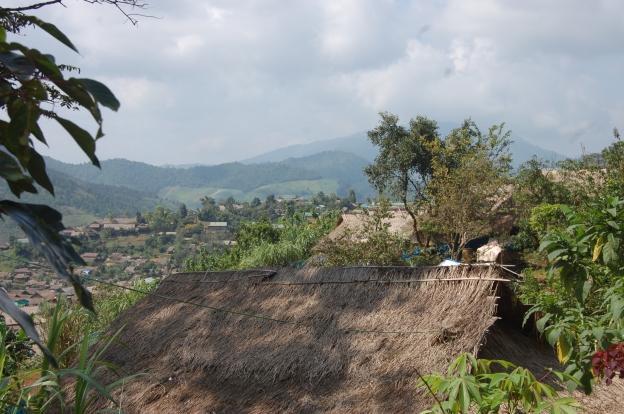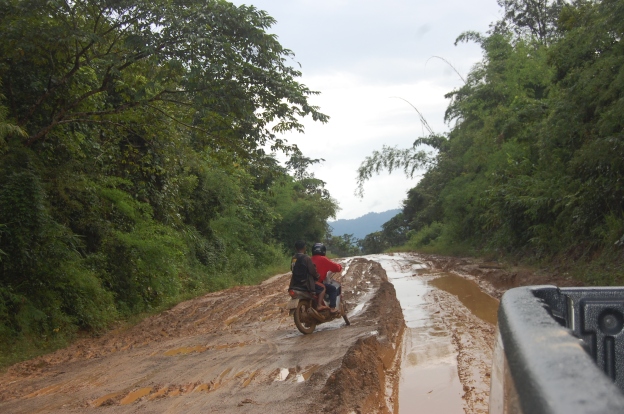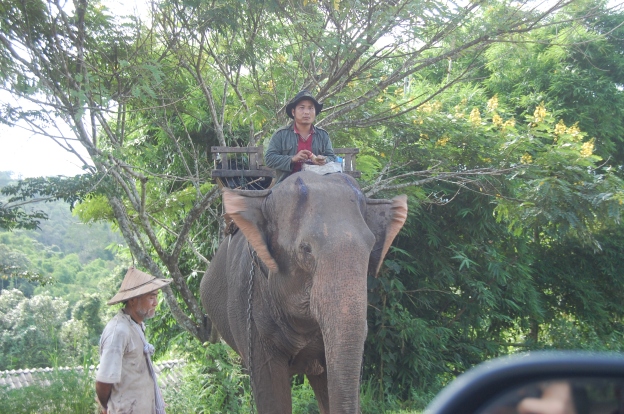The road to Nu Pho is not just one road, nor is it only a surfaced or non-surfaced area. For some the road to Nu Pho started in 1988 with the demonstrations in Burma, for others the road started in a burned down village in Karen State, and for more fortunate ones it might have started with a backpacking trip in South East Asia, a volunteer placement hunt on-line or the desire to find an alternative route from Utrecht to Amsterdam. In the end all these people at some time or other came together in Nu Pho and created a diverse and vibrant community.
As far as physical roads are concerned, Nu Pho is accessible from two directions. From the west comes the road out of Burma and the Thai town Paung Klain, and from the north-east comes the road from Umphang and Mae Sot. The road coming out of Burma is a dirt path that is hardened and dusty in the dry season; muddy and wet in the wet season. Travel time during the latter period can be twice or four times as much as in the dry season. The 45 minutes that it takes to get from Paung Klain to Nu Pho takes the traveller over a surfaced road, heavily potholed and littered with gravel that causes multiple accidents with motorcycles and other transportation modes.
The road coming from Mae Sot and Umphang has been surfaced for quite some time, with some stretches in need of some repair. The early stretches just outside of Mae Sot are 4 lanes wide and offer an uninterrupted view of the fields as all shade giving trees have been cut to make way for the road extensions. The view of the rice paddies is also fading as rice fields make place for concrete constructions as is habitually after a road has been build or widened.
The 4 lane road later turns to 2 lane although some stretches are 4 lane again. It took some time to realise this was not only bad planning, as are many things in Thailand, it was and is also a method to keep local traffic in villages separated from through traffic.
After village 48, suitably located 48 kilometers after you have left Mae Sot, the road makes a turn of 90 degrees to the left and 12 %* skyward. (*this is a non-scientific guess by someone who once cycled this road and matches muscles ache-speed-tiredness-cursing to establish a percentage for an ascent.) The road then changes from great to fabulous. It has been calculated, not by the same person who came up with the percentage thing, that there are 1219 curves in the road between Mae Sot and Umphang, and most of those are incredibly beautiful or horribly vomit inducing, depending on the personal experience.
Umpiem Mai
It is 38 kilometers more before there is a pleasant stop at an ever increasing rest place. Thirteen years ago, the same place was an area with two toilet blocks and a 4 square meters little office with a small counter where a hot thermo and a stack of three-in-one coffee gave the first glimpses of what was to come. The entrepreneurial spirit of a government worker, responsible for safe keeping the area and the road behind, later gave way to several eating places, a small market and the first coffee shop in what soon will be a world dominating coffee chain serving coffee that is grown in the hills around the area. With a mug in hand, standing on the edges of the parking spaces you can have a look at Umpiem Mai, a refugee camp that was established in August 1999 to house refugees who had just seen their second camp burned down, and for some their third house.
The stop is usually about 20 minutes after which the road goes on, although a few minutes later there is a stop to allow those who wish to disembark in Umpiem Mai to do so, while others might get on. So far the car might have been the transportation vehicle for up to 25 or 30 people, sitting on the narrow benches, hunching and hanging in the narrower aisle, hanging on the back or sitting on top. Although the prices are the same, some people see the rooftop as VIP, hanging on the back as First Class, sitting on the bench Second Class and sitting on the floor Third Class. This might some how be edited during the rainy season. And others disagree with these classifications.
After Umpiem Mai it is a further 76 kilomters to Umphang, a lovely little town in a gorgeous valley full of rice paddies, and surrounded by hills. In many occasions, the traveller to Nu Pho will not enter Umphang as a few kilometers before the town, the road to Nu Pho starts and a line-car exchange is set up at the crossroads. The stop can take two minutes or half an hour. Nu Pho is then a further 65 kilometers away and the road is good for the first 17 or so, as this brings the travellers to the entrance of one of Thailand’s most venerated waterfalls: Thee Lor Su, which is the Karen name for: Big Water Fall. The fact that the Thai have adopted the name is a clear proof that the Karen have occupied an area that is greater than what they actually control now. On both sides of teh border.
After Tee Lor Su, most travellers are Burmese going home, locals going home and refugees and the aid workers who come assist. And ESC teachers. Therefore the road now gets more adventurous. Every year big machines come to flatten and harden the road, and every year big chunks of road are re-tarmacced and otherwise repaired, however always in such a way that it is needed again pretty soon. And although it would be easily possible to surface the road in one year from Umphang to Paing Klair, it never happens.
Especially in the rainy season, the last few kilometers before Nu Pho can be very muddy, with walls on either side of the trucks up to a meter and a half high. Despite these barriers, people keep travelling up and down, and ESC has never been out of teachers because of the road situation. This shows how dedicated the teachers are, how rewarding it is to teach a group of knowledge craving people.









































